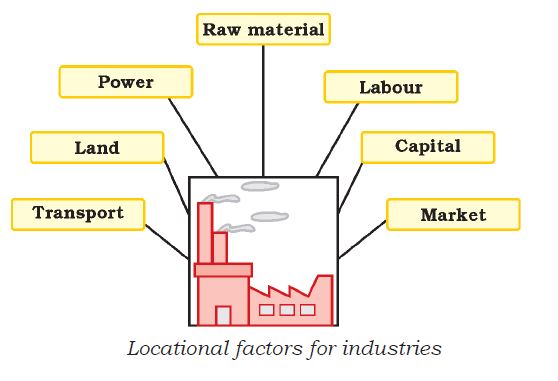Factors responsible for the location of primary sector industries in various parts of the world
Factors responsible for location of Industries
Industrial locations are complex in nature. These are influenced by the availability of many factors. Some of them are: raw material, land, water, labor, capital, power, transport, and market.

For ease of convenience, we can classify the location factors into two: geographical factors and non-geographical factors.
Geographical Factors
- Raw material: Availability of natural resource that can be used as raw material.
- Technology: To turn the resource into an asset with value.
- Power: To utilize the technology.
- Labour: Human resource in the area who can function as labor to run the processes.
- Transport : Road/rail connectivity.
- Storage and warehousing.
- Marketing feasibility.
- Characteristics of land and soil.
- Climate.
- Precipitation and water resources.
- Vulnerability to natural resources.
Explanation:
- Raw materials are one of the important factors in an industrial location. The mere location of industries itself may be determined by the availability or location of the raw materials.
- Power – conventional (coal, mineral oil or hydro-electricity) or on- conventional in nature is a necessity for any industrial establishment.
- Availability of labor or skilled workforce is the success mantra for the growth of all industries.
- Availability of easy transportation always influences the location of the industry. So the junction points of waterways, roadways and railways become humming centers of industrial activity.
- The finished goods should reach the market at the end of the process of manufacturing. Thus nearness to the market is an add-on quality in the process of selecting a location for industry.
- Availability of water is another factor that influences the industrial location. Many industries are established near rivers, canals, and lakes, because of this reason. Iron and steel industry, textile industries and chemical industries require large quantities of water, for their proper functioning.
- The site that is selected for the establishment of an industry must be flat and well served by adequate transport facilities.
- The climate of the area selected for the industry is important, very harsh climate are not suitable for the successful industrial growth.
Non-geographical Factors
- Capital investment.
- Availability of loans.
- Investment climate.
- Government policies/regulations.
- Influence of pressure groups.
Explanation:
- Capital or huge investment is needed for the establishment of industries.
- Government policies are another factor that influences industrial location. The government sets certain restriction in the allocation of land for industries in order to reduce regional disparities, to control excessive pollution and to avoid the excessive clustering of industries in big cities.
- Industrial inertia is the predisposition of industries or companies to avoid relocating facilities even in the face of changing economic circumstances that would otherwise induce them to leave. Often the costs associated with relocating fixed capital assets and labor far outweigh the costs of adapting to the changing conditions of an existing location.
- Efficient and enterprising organization and management are essential for running modem industry successfully.
- The location that has better banking facilities and Insurance are best suited for the establishment of industries.
It is rarely possible to find all these factors available at one place. Consequently, manufacturing activity tends to locate at the most appropriate place where all the factors of industrial location are either available or can be arranged at lower cost. In general, it should also be noted that both lower production cost and lower distribution cost are the two major factors while considering the location of an industry. Sometimes, the government provides incentives like subsidized power, lower transport cost, and other infrastructure so that industries may be located in backward areas.
Industrial System
An industrial system consists of inputs, processes, and outputs. The inputs are the raw materials, labor, and costs of land, transport, power and other infrastructure. The processes include a wide range of activities that convert the raw material into finished products. The outputs are the end product and the income earned from it. In the case of the textile industry, the inputs may be cotton, human labor, factory and transport cost. The processes include ginning, spinning, weaving, dyeing, and printing. The output is the shirt you wear.
Connection between Industrialization and Urbanization
After an industrial activity starts, urbanization follows. Sometimes, industries are located in or near the cities. Thus, industrialization and urbanization go hand in hand. Cities provide markets and also provide services such as banking, insurance, transport, labor, consultants and financial advice, etc. to the industry.
Agglomeration Economies
Many industries tend to come together to make use of the advantages offered by the urban centers known as agglomeration economies. Gradually, a large industrial agglomeration takes place.
Industries in pre-Independence period
In the pre-Independence period, most manufacturing units were located in places from the point of view of overseas trade such as Mumbai, Kolkata, Chennai, etc. Consequently, there emerged certain pockets of industrially developed urban centers surrounded by a huge agricultural rural hinterland.
